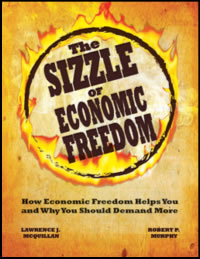
Most Minnesotans don’t realize what restrictions on their economic freedom are costing them. If they realized the benefits that would flow to them with more economic freedom, they would be beating down the doors of the legislature demanding not just a stop to proposed government curtailment of their right to economic liberty, they would be demanding back the freedoms that have been taxed and regulated from them.
That was the message Dr. Lawrence J. McQuillan, director of Business and Economic Studies delivered yesterday at a lunch sponsored by the Minnesota Free Market Institute. Using data collected as part of the U.S. Economic Freedom Index and other studies that rank states based on their degrees of economic freedom, Dr. McQuillan dubbed Minnesota a “4th quintile state”: On the key competitive rankings of state borrowing, taxes, spending, regulations and legal climate, Minnesota consistently ranks well below average.
Minnesota state and local per capita debt burden and debt service as a share of tax revenue is growing. The state has a crushing uncompetitive tax code that hits small business and corporations particularly hard. On spending, Minnesota is moving in the right direction, cutting state spending, but the state still spends more than half the other states. Regulation is on the rise. Minnesota lags behind other states in tort reform to limit lawsuit abuse. Minnesota has no statutory tax or expenditure limits.
This diminishment of economic freedom has significant impact on individual Minnesotans, which rolls up into a negative effect on the state economy.
Economic freedom is simply the right individuals to own what they earn and choose how to use that income; the right of individuals to produce what they want in accordance with their own values; and the right to compete in product and labor markets of their choosing – without resort to force or fraud. Any government action that curtails that freedom is necessarily damaging to individual and state prosperity.
Relying on data from the numerous studies reviewed in “The Sizzle of Economic Freedom,” Dr. McQuillan noted that greater economic freedom leads to higher personal incomes, less unemployment, faster economic growth, more macroeconomic stability, greater capital investment and productivity, more business start-ups, more entrepreneurship and innovation, a better educated workforce, less poverty and inequality, better health, greater population inflows, a cleaner environment and an overall better quality of life.
When the country of Ireland took steps to expand its degree of economic freedom, its economy boomed. With a population or 4.2 million people, Ireland has a $285 billion economy. With 5.2 million people, Minnesota has a $255 billion economy. Minnesota, with more people produces less wealth. Are Minnesotans that much less productive than the Irish, or might it have something to do with our level of economic freedom?
Dr. McQuillan’s presentation is available here.
Cross-posted at the Minnesota Free Market Institute, comments welcome there.
The Sizzle of Economic Freedom and the Fizzle of Minnesota
Craig Westover
Most Minnesotans don’t realize what restrictions on their economic freedom are costing them. If they realized the benefits that would flow to them with more economic freedom, they would be beating down the doors of the legislature demanding not just a stop to proposed government curtailment of their right to economic liberty, they would be demanding back the freedoms that have been taxed and regulated from them.
That was the message Dr. Lawrence J. McQuillan, director of Business and Economic Studies delivered yesterday at a lunch sponsored by the Minnesota Free Market Institute. Using data collected as part of the U.S. Economic Freedom Index and other studies that rank states based on their degrees of economic freedom, Dr. McQuillan dubbed Minnesota a “4th quintile state”: On the key competitive rankings of state borrowing, taxes, spending, regulations and legal climate, Minnesota consistently ranks well below average.
Minnesota state and local per capita debt burden and debt service as a share of tax revenue is growing. The state has a crushing uncompetitive tax code that hits small business and corporations particularly hard. On spending, Minnesota is moving in the right direction, cutting state spending, but the state still spends more than half the other states. Regulation is on the rise. Minnesota lags behind other states in tort reform to limit lawsuit abuse. Minnesota has no statutory tax or expenditure limits.
This diminishment of economic freedom has significant impact on individual Minnesotans, which rolls up into a negative effect on the state economy.
Economic freedom is simply the right individuals to own what they earn and choose how to use that income; the right of individuals to produce what they want in accordance with their own values; and the right to compete in product and labor markets of their choosing – without resort to force or fraud. Any government action that curtails that freedom is necessarily damaging to individual and state prosperity.
Relying on data from the numerous studies reviewed in “The Sizzle of Economic Freedom,” Dr. McQuillan noted that greater economic freedom leads to higher personal incomes, less unemployment, faster economic growth, more macroeconomic stability, greater capital investment and productivity, more business start-ups, more entrepreneurship and innovation, a better educated workforce, less poverty and inequality, better health, greater population inflows, a cleaner environment and an overall better quality of life.
When the country of Ireland took steps to expand its degree of economic freedom, its economy boomed. With a population or 4.2 million people, Ireland has a $285 billion economy. With 5.2 million people, Minnesota has a $255 billion economy. Minnesota, with more people produces less wealth. Are Minnesotans that much less productive than the Irish, or might it have something to do with our level of economic freedom?
Dr. McQuillan’s presentation is available here.
Cross-posted at the Minnesota Free Market Institute, comments welcome there.
Nothing contained in this blog is to be construed as necessarily reflecting the views of the Pacific Research Institute or as an attempt to thwart or aid the passage of any legislation.